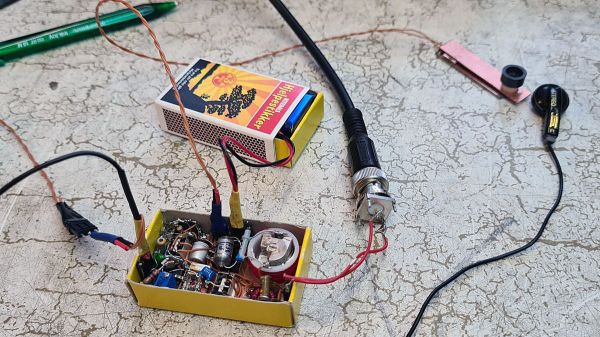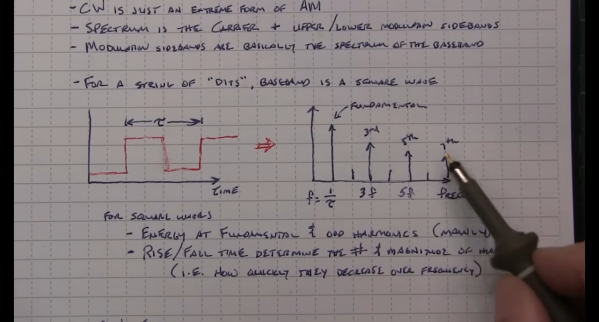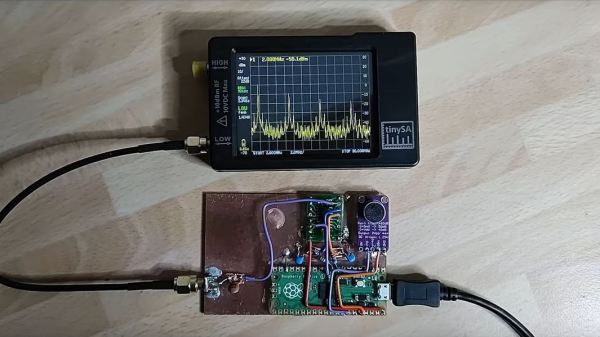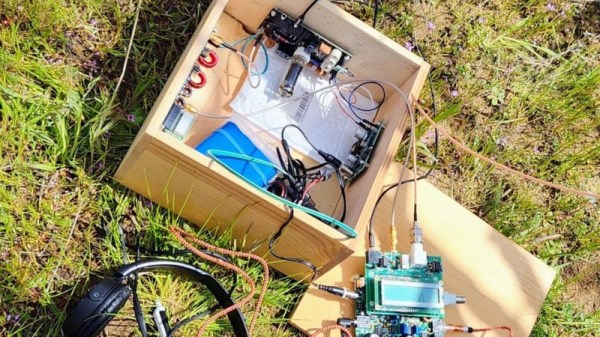In the relatively short time that the James Webb Space Telescope has been operational, there’s seemingly no end to its list of accomplishments. And if you’re like us, you were sure that Webb had already achieved the first direct imaging of a planet orbiting a star other than our own a long time ago. But as it turns out, Webb has only recently knocked that item off its bucket list, with the direct visualization of a Saturn-like planet orbiting a nearby star known somewhat antiseptically as TWA 7, about 111 light-years away in the constellation Antlia. The star has a significant disk of debris orbiting around it, and using the coronagraph on Webb’s MIRI instrument, astronomers were able to blot out the glare of the star and collect data from just the dust. This revealed a faint infrared source near the star that appeared to be clearing a path through the dust.
morse36 Articles
CW Not Hard Enough? Try This Tiny Paddle
For a long time, a Morse code proficiency was required to obtain an amateur radio license in many jurisdictions around the world, which was a much higher bar of entry than most new hams have to pass. Morse, or continuous wave (CW) is a difficult skill to master, and since the requirement has been dropped from most licensing requirements few radio operators pick up this skill anymore. But if you like a challenge, and Morse itself isn’t hard enough for you, you might want to try out this extremely small Morse paddle.
Originally meant for portable operation, where hiking to something like a mountain top with radio gear demands small, lightweight, and low-power options, this paddle is actually not too complex. It attaches to most radios with a 3.5 mm stereo cable and only has two paddles on flexible metal arms which, when pressed against the center of the device, tell the radio to either produce continuous “dits” or “dahs”. For portable use the key sits inside a tiny plastic case and only needs to be pulled out and flipped around to get started. And, while not waterproof, [N6ARA] reports that it’s so small you likely could just shield it from the rain with your other hand if you needed to.
Presumably, this paddle actually wouldn’t be that much different than using any other paddle except for the fact that it’s not heavy enough to resist the force of use, so you’d have to hold it with your other hand anyway. And, while this is a product available for purchase it’s simple enough that, presumably, the design could easily be duplicated with just a few parts. Paddles like this were made as an improvement to older technology like straight keys which require the operator to produce the correct lengths of tones for each character manually. While you can get higher speeds with a paddle, there are still some dedicated CW operators using a straight key.
Learning Morse Code With A DIY Trainer
Morse code, often referred to as continuous wave (CW) in radio circles, has been gradually falling out of use for a long time now. At least in the United States, ham radio licensees don’t have to learn it anymore, and the US Coast Guard stopped using it even for emergencies in 1999. It does have few niche use cases, though, as it requires an extremely narrow bandwidth and a low amount of power to get a signal out and a human operator can usually distinguish it even if the signal is very close to the noise floor. So if you want to try and learn it, you might want to try something like this Morse trainer from [mircemk].
While learning CW can be quite tedious, as [mircemk] puts it, it’s actually fairly easy for a computer to understand and translate so not a lot of specialized equipment is needed. This build is based around the Arduino Nano which is more than up for the job. It can accept input from any audio source, allowing it to translate radio transmissions in real time, and can also be connected to a paddle or key to be used as a trainer for learning the code. It’s also able to count the words-per-minute rate of whatever it hears and display it on a small LCD at the front of the unit which also handles displaying the translations of the Morse code.
If you need a trainer that’s more compact for on-the-go CW, though, take a look at this wearable Morse code device based on the M5StickC Plus instead.
Matchbox Transceiver Pushes The Spy Radio Concept To Its Limits
The Altoids tin has long been the enclosure of choice for those seeking to show off their miniaturization chops. This is especially true for amateur radio homebrewers — you really have to know what you’re doing to stuff a complete radio in a tiny tin. But when you can build an entire 80-meter transceiver in a matchbox, that’s a whole other level of DIY prowess.
It’s no surprise that this one comes to us from [Helge Fykse (LA6NCA)], who has used the aforementioned Altoids tin to build an impressive range of “spy radios” in both vacuum tube and solid-state versions. He wisely chose solid-state for the matchbox version of the transceiver, using just three transistors and a dual op-amp in a DIP-8 package. There’s also an RF mixer in an SMD package; [Helge] doesn’t specify the parts, but it looks like it might be from Mini-Circuits. Everything is mounted dead bug style on tiny pieces of copper-clad board that get soldered to a board just the right size to fit in a matchbox.
A 9 volt battery, riding in a separate matchbox, powers the rig. As do the earbud and tiny Morse key. That doesn’t detract from the build at all, and neither does the fact that the half-wave dipole antenna is disguised as a roll of fishing line. [Helge]’s demo of the radio is impressive too. The antenna is set up very low to the ground to take advantage of near vertical incidence skywave (NVIS) propagation, which tends to direct signals straight up into the ionosphere and scatter them almost directly back down. This allows for medium-range contacts like [Helge]’s 239 km contact in the video below.
Banging out Morse with no sidetone was a challenge, but it’s a small price to pay for such a cool build. We’re not sure how much smaller [Helge] can go, but we’re eager to see him try.
Continue reading “Matchbox Transceiver Pushes The Spy Radio Concept To Its Limits”
How Much Bandwidth Does CW Really Occupy?
Amateur radio license exams typically have a question about the bandwidths taken up by various modulation types. The concept behind the question is pretty obvious — as guardians of the spectrum, operators really should know how much space each emission type occupies. As a result, the budding ham is left knowing that continuous wave (CW) signals take up a mere 150 Hertz of precious bandwidth.
But is that really the case? And what does the bandwidth of a CW signal even mean, anyway? To understand that, we turn to [Alan (W2AEW)] and his in-depth look at CW bandwidth. But first, one needs to see that CW signals are a bit special. To send Morse code, the transmitter is not generating a tone for the dits and dahs and modulating a carrier wave, rather, the “naked” carrier is just being turned on and off by the operator using the transmitter’s keyer. The audio tone you hear results from mixing the carrier wave with the output of a separate oscillator in the receiver to create a beat frequency in the audio range.
That seems to suggest that CW signals occupy zero bandwidth since no information is modulated onto the carrier. But as [Alan] explains, the action of keying the transmitter imposes a low-frequency square wave on the carrier, so the occupied bandwidth of the signal depends on how fast the operator is sending, as well as the RF rise and fall time. His demonstration starts with a signal generator modulating a 14 MHz RF signal with a simple square wave at a 50% duty cycle. By controlling the keying frequency, he mimics different code speeds from 15 to 40 words per minute, and his fancy scope measures the occupied bandwidth at each speed. He’s also able to change the rise and fall time of the square wave, which turns out to have a huge effect on bandwidth; the faster the rise-fall, the larger the bandwidth.
It’s a surprising result given the stock “150 Hertz” answer on the license exam; in fact, none of the scenarios [Allen] tested came close to that canonical figure. It’s another great example of the subtle but important details of radio that [Alan] specializes in explaining.
Continue reading “How Much Bandwidth Does CW Really Occupy?”
Pico-Sized Ham Radio
There are plenty of hobbies around with huge price tags, and ham radio can certainly be one of them. Experienced hams might have radios that cost thousands of dollars, with huge, steerable antennas on masts that can be similarly priced. But there’s also a side to the hobby that throws all of this out of the window in favor of the simplest, lowest-cost radios and antennas that still can get the job done. Software-defined radio (SDR) turned this practice up to 11 as well, and this radio module uses almost nothing more than a microcontroller to get on the air.
The design uses the capabilities of the Raspberry Pi Pico to handle almost all of the radio’s capabilities. The RF oscillator is driven by one of the Pico’s programmable I/O (PIO) pins, which takes some load off of the processor. For AM and SSB, where amplitude needs to be controlled as well, a PWM signal is generated on another PIO which is then mixed with the RF oscillator using an analog multiplexer. The design also includes a microphone with a preamplifier which can be fed into a third PIO; alternatively it can receive audio from a computer via the USB interface. More processor resources are needed when generating phase-modulated signals like RF, but the Pico is still quite capable of doing all of these tasks without jitter larger than a clock cycle.
Of course this only outputs a signal with a few milliwatts of power, so for making any useful radio contacts with this circuit an amplifier is almost certainly needed. With the heavy lifting done by the Pico, though, the amplifier doesn’t need to be complicated or expensive. While the design is simple and low-cost, it’s not the simplest radio possible. This transmitter sends out radio waves using only a single transistor but you will be limited to Morse code only.
The Peak Of Vacuum Tube Radio Design
One of the more popular trends in the ham radio community right now is operating away from the shack. Parks on the Air (POTA) is an excellent way to take a mobile radio off-grid and operate in the beauty of nature, but for those who want to take their rig to more extreme locations there’s another operating award program called Summits on the Air (SOTA) that requires the radio operator to set up a station on a mountaintop instead. This often requires lightweight, low-power radios to keep weight down for the hike, and [Dan] aka [AI6XG] has created a radio from scratch to do just that.
[Dan] is also a vacuum tube and CW (continuous wave/Morse code) operator on top of his interest in summiting various mountains, so this build incorporates all of his interests. Most vacuum tubes take a lot of energy to operate, but he dug up a circuit from 1967 that uses a single tube which can operate from a 12 volt battery instead of needing mains power, thanks to some help from a more modern switch-mode power supply (SMPS). The SMPS took a bit of research, though, in order to find one that wouldn’t interfere with the radio’s operation. That plus a few other modern tweaks like a QCX interface and a switch to toggle between receive to transmit easily allows this radio to be quite versatile when operating while maintaining its portability and durability when summiting.
For those looking to replicate a tube-based radio like this one, [Dan] has made all of the schematics available on his GitHub page. The only other limitation to keep in mind with a build like this is that it tends to only work on a very narrow range of frequencies without adding further complexity to the design, in this case within the CW portion of the 40-meter band. But that’s not really a bad thing as most radios with these design principles tend to work this way. For some other examples, take a look at these antique QRP radios for operating using an absolute minimum of power.

















